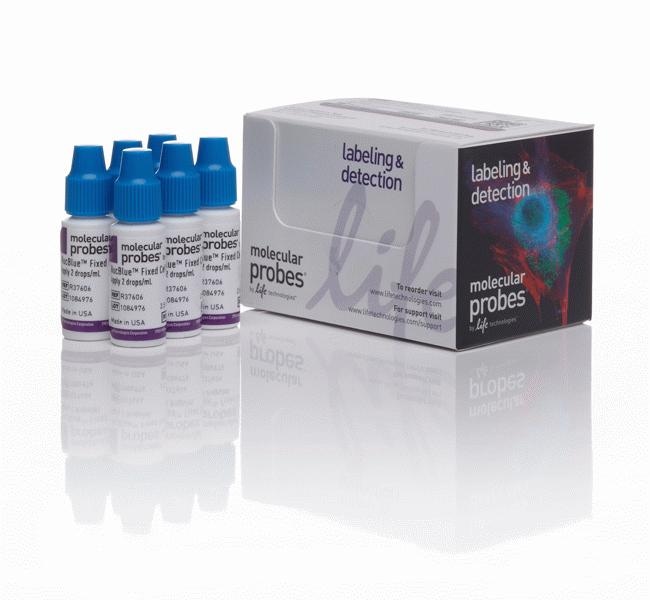Search Thermo Fisher Scientific

NucBlue™ Fixed Cell ReadyProbes™ Reagent (DAPI)
| Catalog Number | Quantity |
|---|---|
| R37606 | 6 vial(s) kit |
Also available: DAPI (4',6-diamidino-2-phenylindole, dihydrochloride) at 12.5X concentration (5 μM) in water.
• No need to dilute, weigh, or pipette
• Convenient dropper bottle—just use two drops per mL
• Stable at room temperature—keep handy at your scope or cell culture area• DAPI is excited with UV light and detected through a blue/cyan filter
See other ReadyProbes reagents for cell staining
See other nuclear stains for imaging
Cell imaging applications
DAPI is a classic fluorescent dye used extensively for nuclear staining of fixed cells. In fluorescence microscopy, DAPI is excited with UV light and detected through a blue/cyan filter (Figure 1)..
Suggestions for use
In most cases 2 drops/ml of NucBlue Fixed Cell Stain and an incubation of 15 to 30 minutes will produce bright nuclear staining; however, optimization may be needed for some cell types, conditions, and applications. In such cases, simply add more, or fewer, drops until the optimal staining intensity is obtained.
• NucBlue Fixed Cell Stain is excited by UV light at 360 nm when bound to DNA, with an emission maximum at 460 nm. It is detected through a blue/cyan filter, such as a DAPI filter, blue GFP filters, or the Semrock BrightLine Alexa Fluor 350 Dye filter set.
• As a preferred blue nuclear stain in fixed cell imaging experiments, NucBlue Fixed Cell Stain is ideal for use with antibody-based applications.
Visualize staining your cell without wasting your reagents, antibodies, or time with our new Stain-iT Cell Staining Simulator.
Store at ≤ 25°C
Figures




















































Videos
EVOS M7000 microscope Z-stack of rat cortical neurons using a 20X S-Apo objective, DAPI, GFP and RFP LED cubes.
Rat cortical neurons (A1084001) transfected with CellLight??? Golgi-RFP, BacMam 2.0 (C10593). At 48 hours cells were fixed and stained with anti-Tau (MN1000), followed by Goat anti-Mouse Alexa Fluor Plus 488 (A32723) and NucBlue??? Fixed Cell ReadyProbes??? Reagent (R37606). Cells were imaged on an M7000 (AMF7000) using an Olympus 20X objective (AMEP4734) with DAPI (AMEP4650), GFP (AMEP4651) and RFP (AMEP4652) LED cubes.
Customers who viewed this item also viewed
Documents & Downloads
Certificates
Safety Data Sheets
Scientific Resources
Product Information
Frequently asked questions (FAQs)
Some mounting medias can have strong blue autofluorescence. If you are seeing a high blue background, it could be coming from the mountant. Try labeling the sample and view it before (using a wet mount in buffer) and after mounting to determine if the background signal is coming from the mounting media or the sample itself.
Find additional tips, troubleshooting help, and resources within our Cell Analysis Support Center.
We do not have a direct alternative for the discontinued 3-Germ Layer ICC Kit (Cat. No. A25538). However, we do have alternative primary and secondary antibodies, as well as reagents, that can be used for trilineage differentiation. Please note that we have not internally validated the use of all these reagents together.
We recommend the following primary antibodies:
Alpha-Smooth Muscle Actin Monoclonal Antibody (1A4 (asm-1)) (Cat. No. MA5-11547)
alpha-Fetoprotein Monoclonal Antibody (AFP3) (Cat. No. 14-6583-80)
beta-3 Tubulin Monoclonal Antibody (2G10) (Cat. No. MA1-118)
We recommend the following secondary antibodies:
Goat anti-Mouse IgG2a Cross-Adsorbed, Alexa Fluor 555 (Cat. No. A21137)
Goat anti-Mouse IgG2a Cross-Adsorbed, Alexa Fluor 594 (Cat. No. A21135)
https://www.thermofisher.com/antibody/product/Goat-anti-Mouse-IgG1-Cross-Adsorbed-Secondary-Antibody-Polyclonal/A-21121
We recommend using the following reagents:
https://www.thermofisher.com/order/catalog/product/88-8824-00
NucBlue Fixed Cell ReadyProbes Reagent (DAPI) (Cat. No. R37606)
Blocker BSA (Cat. No. 37520)
DPBS (10X), no calcium, no magnesium (Cat. No. 14200075)
Find additional tips, troubleshooting help, and resources within our Cell Analysis Support Center.
This is not recommended. The ReadyProbes reagents were developed for imaging applications whereas the Ready Flow reagents were optimized for flow cytometry.
Find additional tips, troubleshooting help, and resources within our Cell Analysis Support Center.
